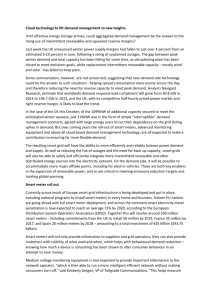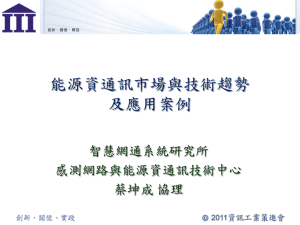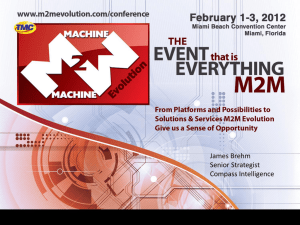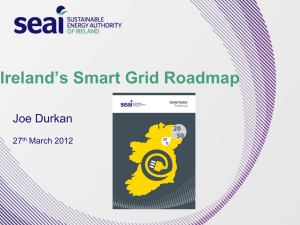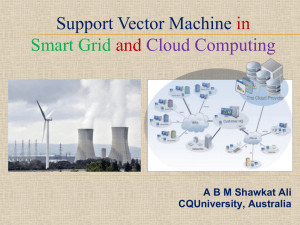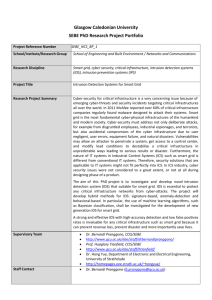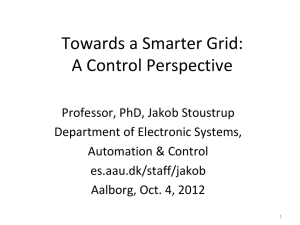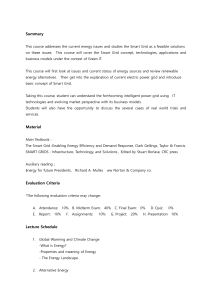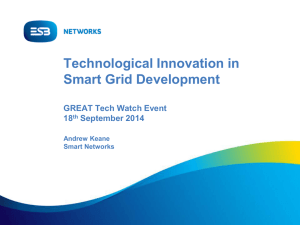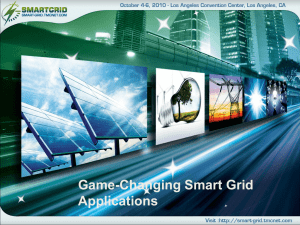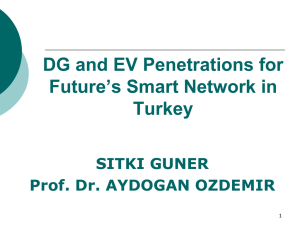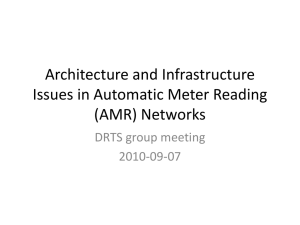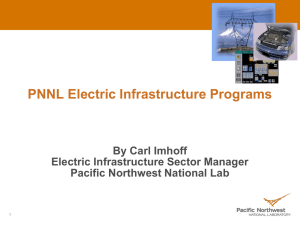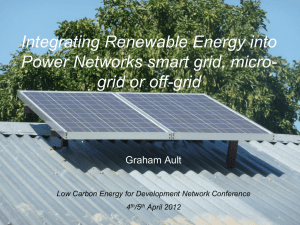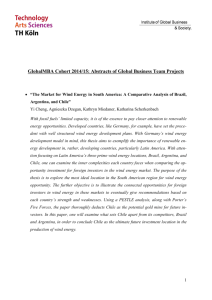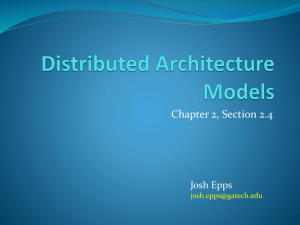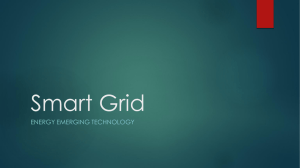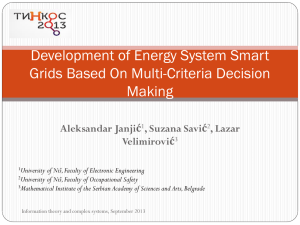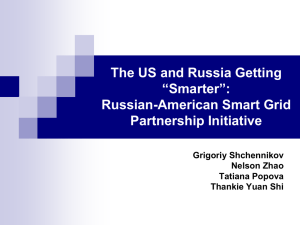The State of the U.S. Grid: Recalibrating Risk and Regulation
advertisement
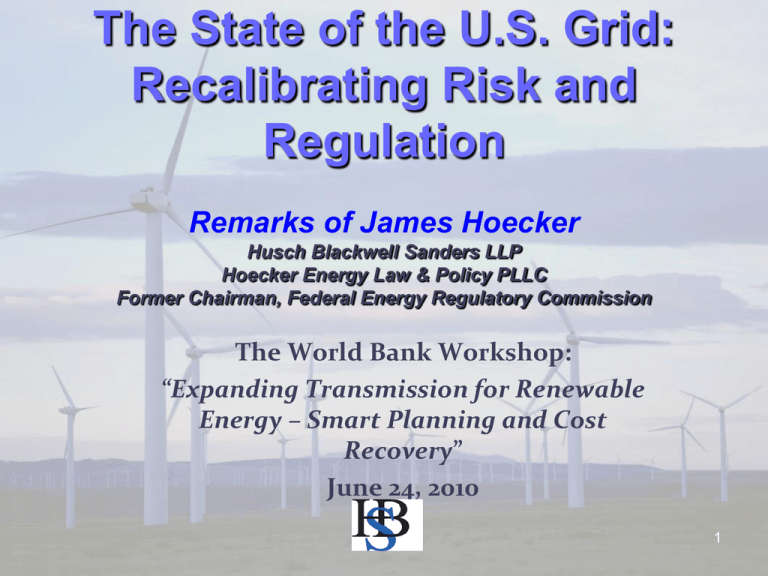
The State of the U.S. Grid: Recalibrating Risk and Regulation Remarks of James Hoecker Husch Blackwell Sanders LLP Hoecker Energy Law & Policy PLLC Former Chairman, Federal Energy Regulatory Commission The World Bank Workshop: “Expanding Transmission for Renewable Energy – Smart Planning and Cost Recovery” June 24, 2010 1 Today’s National Grid Key network infrastructure vital to the nation’s economy A nationwide164,000-mile, highly-integrated network of transmission lines and control facilities, interconnecting over 750,000 MW of generating capacity to millions of customers in all regions, and 3000 utilities 2 “This is your father’s electric system–but it can’t stay that way for long” (Sue Tierney, 2008) The “Grid” Is the Enabler Of New Technologies and System Innovation. Primary Benefits of transmission: network reliability, lower costs of energy/capacity Strategic Benefits: renewable resource development and integration, lower GHG emissions, fuel diversity, market power mitigation Extreme Event Benefits: mitigate impact of multiple contingencies, reduce price volatility from outages Secondary Benefits: economic development, new investment, tax base (LBNL, Public Interest Energy Research) 3 Challenges Confronting Our Transmission System Aging and deteriorating infrastructure More dispersed resources of generation Wholesale competition among generators Complex bulk power markets Arrival of the digital economy Electricity consumption doubled 1980-2007 Shifts of public policy (e.g., RPS, efficiency, demand response) 4 Obstacles to Transmission Upgrades/Expansion “Not in my backyard” or “not in my term of office” Conflicts between local, state and regional interests Inconsistent state and local regulation Uncoordinated environmental reviews Federal land authorization, esp. in the West Lack of timing coordination among siting entities Varying GHG restrictions and RPS’s Difficulty right-sizing for short and long-term needs Uncoordinated siting of lines and generators Timing of “need” determinations Recently, regional resistance to power “imports” and broadened allocations of transmission costs 5 Must We Build More Transmission? NERC: Transmission additions will triple to 3100 miles/year 2009-2018. Project proposals abound: 90 planned projects each greater than $100 million (totaling $120 Billion) Prospects for a clean energy economy—RPS, climate legislation, smart grid; renewable energy projects mean jobs and will drive major transmission expansions and upgrades; 20-30% wind penetration in the East = > $100 Billion for transmission (NREL) Other drivers: reliability, cyber security, replacing aging facilities, new technologies, load growth PROBLEM: approval processes are out of sync with the realities of multi-state, multi-system, multipurpose transmission 6 Q. Who Decides What Best Serves The Public Interest? A. Everybody Siting – Location and Multiple Definitions of “Need” States consider need for facilities when siting them Cost allocation – Who Pays? Who Benefits? States are influenced by the rate impacts on citizens when considering need; recent FERCs defer to states and stakeholders Planning – Which Projects Are Needed? Which Are Not? Stakeholders, regional planners, regulators, or politics can influence whether projects satisfy reliability, economic, environmental, or public policy needs 7 Major Transmission Proposals 8 Transmission Plans: N. America Source: North American Electric Reliability Corporation 9 Where Do We Go From Here? Smart Grid Technology Beats the “Old Technology” Rap – Two-way Communication of Data; Control of Supply and Demand – Automation Enables A Self-Healing Grid – New Visualization Tools Promote Reliability – Other Benefits Include Fuel Diversity, Competitive and Liquid Wholesale Markets; Market Power Mitigation; Risk Mitigation and Price Stability – Smart Tech Not a Panacea for Aging Infrastructure or Access to Renewable Energy Resolving Economic – Regulatory Conflicts -- Regulation versus Entrepreneurialism -- Public Utility Business Model Reform of Policy and Procedure ----- Opposition to cost socialization Opposition to federal oversight of planning Resistance to standardization Assurance of cost recovery 10 Voices of Transition “The way we look at it, the grid’s been smart for awhile. It takes some pretty sophisticated tools to monitor, dispatch, and control electricity flow.” -- A Transmission engineer “Do you know what keeps me up at night? Not my programmers. Not my investors. Not my health care costs. It’s state regulators.” -- A smart grid firm CEO Source: Fox-Penner, Smart Power The Hill, The Spill, and the Climate Bill Positive investment trends in all regions: quadruple the 1990s Interconnection-wide planning efforts (ARRA-funded) More FERC leadership in cost allocation and planning Pending transmission and climate legislation could address planning, siting, and cost allocation to varying degrees– – S.1462 American Clean Energy Leadership Act (E&NR Comm.) – H.R. 2454 American Clean Energy & Security Act (Waxman-Markey) – American Power Act (Kerry-Lieberman-without Graham) 12 James J. Hoecker, JD, Ph.D Husch Blackwell Sanders LLP Hoecker Energy Law & Policy PLLC james.hoecker@huschblackwell.com www.helppllc.com 202-378-2300 www.wiresgroup.com 13
